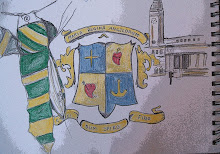
I found these examples of information graphics in the book ‘Graphic Design Sources’ by Kenneth J Hiebert. From these two pieces of information graphics, it is evident that each colour within the pie chart shape is representative of a particular year. However, I don’t think that this is noticeable straight away because from first glance I found the chart quite confusing. I think because the text was so small and the variety of different colours within each example made it appear more complicated than it actually is.
Perhaps colour is not needed to the extent it is used here. Maybe it is enough to have the lines for each year as a colour rather than the block of colour. It would not stand out at you full of colour detracting attention away from the information. I think the inclusion of the numbers showing the population in millions is needed because otherwise you would not have an idea of how particular countries have grown over the past 50 years.
It is also not very obvious from these two examples which countries have grown in population or become less. I think that this is perhaps why the information is displayed and comes across in a complex way. You still have to work it out for yourself rather than have the information simple and understandable in front of you. For example on the first one with the black as the background colour, Mexico City in 2000 was 25.6, in 1980 14.5 and in 1950 it does not appear because it was not in the top ten most populated metropolitan areas. This is not obvious from first look – you really have to study it to find out for yourself.


No comments:
Post a Comment